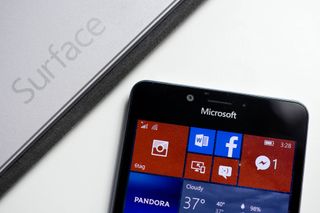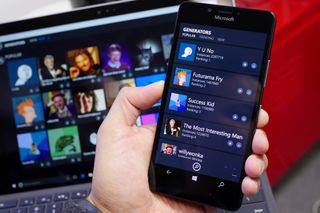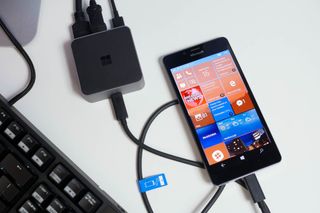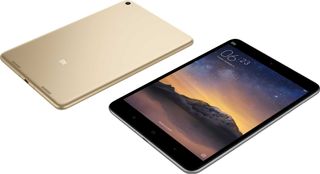How Windows 2-in-1's are setting the stage for the Surface Phone
Windows tablets, like their smartphone cousins, were "late" to the new consumer-focused mobile computing landscape.

It's, therefore, ironic that Windows based 2-in-1s are now increasing in popularity and even influencing the design of rival devices. Conversely, traditional slate tablets, which have dominated the space, are falling out of vogue.
Consequently, Windows 2-in-1 tablets supported by Microsoft's Universal Windows Platform, are propelling Microsoft's mobile vision of context sensitive hardware and software across the mobile landscape.
This "context-conforming" message and the utility of these devices are shaping the minds of the masses around Microsoft's "mobility of experiences" vision for mobile computing. This increasing presence and proliferation of 2-in-1's are profoundly beneficial to Microsoft's present and future Windows "phone" strategy. Here's why.
Team effort

My wife and I recently watched Ant-Man. In the movie, Scott Lang, a formally-educated intellectual finds re-entry into society a challenge after his release from prison for a "Robin Hood"-like money laundering crime. Furthermore, because of his past, he is not respected by his daughter's mother nor her new cop boyfriend.
However, Lang's daughter and Hank Pym, a retired scientist and hero, seem to be among the few people that see beyond the ex-con's failures and maintain a belief in him. Consequently, Lang is enlisted by Pym to don the aging scientist's Ant-Man suit to become Ant-Man.
The transformation required time and, more importantly, a team. He couldn't do it alone.
With Pym's guidance, the support of a team of friends and the alliance of a horde of ants, Lang uses the suit to shrink down to ant size, (increasing in strength), to operate obscurely just out of sight of his enemies.
By the story's end, his success is so profound that he is sought after by earth's mightiest heroes to join the ranks of the Avengers. His transformation required time and, more importantly, a team. He couldn't do it alone.
Get the Windows Central Newsletter
All the latest news, reviews, and guides for Windows and Xbox diehards.
Satya Nadella{.nofollow} shares how a "team" of first-party hardware supports the entire Windows ecosystem:
"We will build first-party hardware to stimulate more demand for the entire Windows ecosystem... we'll develop new categories like we did with Surface… we will responsibly make the market for Windows Phone."
More than phone

Microsoft is much more than Windows phone. As difficult as this is for me to write and for fans to read, if Microsoft's phone efforts fail, the company will still survive. Unlike Apple, which garners 60% of its revenue from the iPhone, Redmond, can survive without a phone. Ultimately, Microsoft's cross-platform app push ensures some form of mobile presence.
Naysayers expect that this is Microsoft's destiny. Fans and the company themselves, however, are among the few who see beyond Redmond's past failures and maintain a belief that their mobile strategy will succeed. Some may view that belief as hopeful delusion. Others, who like Lang's daughter and Pym, who could see beyond an apparently hopeless surface, see the potential of the plan that is operating obscurely just out of sight of the mainstream smartphone market.
Microsoft is resting its success in mobile on the synergistic effects of the broader ecosystem.
Their strategy is founded on the premise that its mobile phones (which are no longer a standalone business) will reap the benefits of the success of other components of the Universal Windows Platform. More successful, and better established members of Redmond's devices ecosystem are at the forefront of Microsoft's efforts to bring the breadth of its solutions to the masses. Panos Panay shares his feeling about bringing unity to Microsoft's product line:
"Yeah, right now, the Lumia line is exactly what it is. We have the Surface line, and we have every other device that the company makes. It really is about bringing them all together with a consistent feeling and making sure the experiences across Microsoft come to our customers."
The ethos of Continuum

Continuum is key. Continuum's not a mere feature of Microsoft's products. It is, rather, a transcendent aspect of Microsoft's ecosystem that helps the firm facilitate its vision to serve the dual user and support mobile experiences across devices. The Surface, which was the first device to showcase Continuum, was born from the belief that a form-shifting hardware device could conform to a user's context supported by equally malleable software.
Consequently, the fundamental ideology driving Microsoft's approach to modern computing - context sensitive hardware and software purposefully designed to conform to a user's needs - is embodied in a Surface running Windows 10. Redmond's goal, of course, is to communicate this ideology to the masses.
They want the industry to embrace their context-sensitive personal computing ethos.
OEM partners have been critical to this process. The proliferation of Windows-based 2-in-1's that are undeniably inspired by Surface are evidence of the early success of Redmond's strategy. Panos Panay makes this point clear in this statement:
"…one of the opportunities was to hopefully inspire others to think about the new categories and the devices we're creating… We're seeing this category beginning to take off a little bit right now. That's a good thing. I think Surface is one of the main drivers of that."
Windows tablets on the rise

When the iPad made tablets a thing in 2010, Microsoft was MIA. From 2010 to 2012 the iPad and a horde of Android tablets ruled the tablet space while Microsoft, no doubt, was honing the Surface. Expensive Windows tablets eventually entered the scene but could not compete with bargain basement priced Android tablets and the better-branded iPad. Thus, Windows-based tablets initially saw little success.
That story has since changed. As of the first nine months of 2015, Windows tablets have seen a 58% YOY increase in shipments. 2-in-1's, boasting Continuum, have made up the bulk of these devices. Eric Smith, Senior Analyst, Tablet & Touchscreen Strategies Services says it like this:
"Windows devices now run the gamut from 2-in-1 Tablets from E-Fun in the US starting at $139 retail, to Microsoft's Surface Book starting at $1499 retail… Windows 10 provides a stable base from which the ecosystem can grow, and we are entering a world where Windows Tablets take significant market share from Android Tablets on the low end and compete head-to-head with iPad in the high and premium segments."
By Q4 2014, Microsoft held about 7% of the tablet space. Strategy Analytics estimates 22 million Windows tablets will ship by the end of 2015 thereby garnering 10% of the market. This momentum is expected to continue into 2019 with a 120% increase above current levels with 49 million units shipped.
Naturally, the proliferation of Windows 2-in-1's also means a proliferation of Microsoft's ethos. Context-sensitive hardware and software are becoming the default Microsoft Windows experience in the industry.
Additionally, it is expected that IT departments will also embrace 2-in-1's in masse. IDC Tablets and Research Director Jean Philippe Bouchard shares:
"It will take some time, but we expect that once IT departments are done evaluating Windows 10 and the awaited iPad Pro, they will start migrating some [of] their portable PC and tablet installed base toward 2-in-1s, which will accelerate the adoption of the form factor."
Shifting fortunes

Despite the growth of Windows tablets, that growth is occurring within a context of a shrinking tablet space. As Ryan Reith, Program Director at market research and analytics firm IDC put it:
"…as the smartphone installed base continues to grow, and the devices get bigger and more capable, the need for smaller form factor slate tablets becomes less clear. With shipment volumes slowing over four consecutive quarters, the market appears to be in transition.
The tablet space is undergoing a shift. Detachable tablets are becoming the preferred form factor over the traditional slate. Microsoft, who has invested not only in the hardware that fits this paradigm but also the necessary software, is well positioned for this shift. Redmond's UWP with Continuum that allows for apps and the OS's UI to flow naturally with a user's context is ahead of the curve.
Apple's iPad Pro and Google's Pixel C, though they mimic the detachable form factor, do not boast the [software necessary](http:// arstechnica.com/gadgets/2015/12/the-pixel-cs-bumpy-road-from-chrome-os-concept-to-android-adoptee) to support a user's transition seamlessly across form factors.
Falling into place
According to the IDC global smartphone growth, like slate tablets, is also slowing. Windows Phone's 10% decline, which reflects Microsoft's retrenching efforts, have contributed to this decline.
Apple, however, is also seeing less demand for the iPhone. According to Morgan Stanley, Apple's flagship device seems negatively affected by a maturing smartphone market. Moreover, the bulk of iPhone sales are not to new smartphone users. They are, rather, part of a replacement market where a consumer is replacing an existing phone.
IDC is predicting that by 2019, Apple's market share will drop to 14.1% from 15.8%. Android will grow to 82.6%, up from 81%. Windows Phone will account for 2.3% up from 2.2%. These predictions, of course, are for devices that fit the current paradigm of what qualifies as a smartphone. Microsoft, however, is expected to introduce a new category of device in Q4 2016.

As the Surface redefined the tablet and the Surface Book redefined the laptop, what has been dubbed the Surface "Phone" is expected to redefine the phone. The stage is being set, and everything is falling into place.
The growing appeal of 2-in-1's is establishing Microsoft's context-sensitive hardware/software mobile vision.
The growing consumer embrace of this ideology and device utility combined with the market growth of phablets and the resulting decreased appeal of slate tablets is the ideal backdrop for a new type of "phone". Microsoft Scientist Stevie Bathiche offers the following regarding the advent of new device form factors:
"Every new computing form factor is preceded by a new human-computer interaction model… success is innovating and creating those new categories using that new interaction modality. In the future, we hope to see… new computing form factors that are unlocked by a new way of interacting with the machine."
Team Player
Like Ant-Man, Microsoft's diminutive phone division is positioned to reap the benefits of a supportive team. Windows 10 and 2-in-1 tablets have paved the way. During Microsoft's annual shareholders meeting Nadella shared:
"…we are seeing, for the first time on the core of Windows desktop, with 100-plus million users, active engagement... This is new. We've had different efforts in the past, but we now have one store and one app platform. Give us time to keep focused on it."
With 2.5 billion visits to the Store since Windows 10's launch four months ago there is a reason for hope. This early success should be enticing to developers and positive data for the app Bridges. It is also inspiring considering Nadella's assertion that all points of entry into the UWP lead to phone.
Additionally, Panos' passion for a consistent feel across first-party Microsoft devices, I'm confident goes beyond the aesthetics of the hardware's fit and finish. The transformative nature of the hardware is also a consistent Surface theme. That a device is something and something else by virtue of its physical design is a fundamental theme of Microsoft's products.
Consider. Surface is a tablet and a laptop. Surface Book is a laptop and a digital clipboard. Band is a fitness tracker and a smartwatch. This is Microsoft's story. Surface "phone" will not be just a phone.
From Zero to Hero
While retrenched, operating obscurely just out of sight of rivals, Microsoft's Windows 10 Surface "phone" may emerge as that hero device that elicits desire from the masses and inspires emulation among OEMs. If so, the Surface "phone" will not have gotten there alone. There will have been a team of 2-in-1's, establishing Microsoft's mobile computing ideology, through innovative hardware and software.

The Surface and affordable Surface inspired 2-in-1's are the "team" preparing the masses for Microsoft's category creating "phone".
A phone that may replace your tablet and become your PC.
Jason L Ward is a columnist at Windows Central. He provides unique big picture analysis of the complex world of Microsoft. Jason takes the small clues and gives you an insightful big picture perspective through storytelling that you won't find *anywhere* else. Seriously, this dude thinks outside the box. Follow him on Twitter at @JLTechWord. He's doing the "write" thing!

